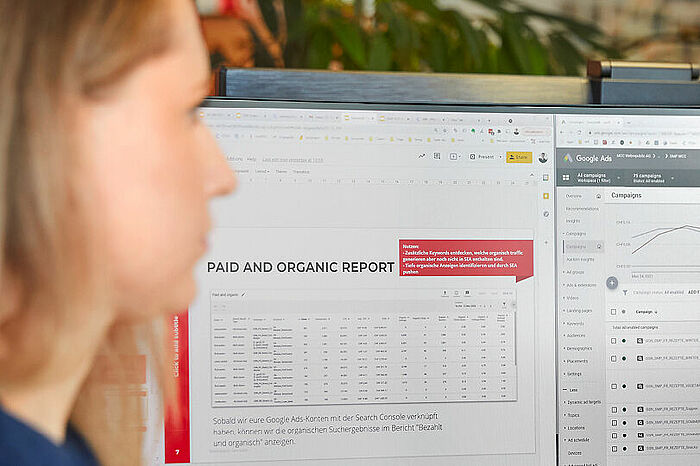Google recently announced that they will stop using third-party cookies and similar frameworks that allow for identifying individual users. The announcement has put a renewed spotlight on the fast-changing regulatory and technological environments in which digital marketing lives. Fundamentally, Google is betting on new, more privacy-conscious web browser features in enabling advertising use cases, such as remarketing or conversion measurement. We give an overview of ways to handle the “cookie crumble”.
Google published a blog post on their Ads & Commerce Blog that made waves in the digital marketing world. In it, they doubled down on their plans to phase out third-party cookies in Chrome while also stressing that they were not looking for an alternative way to track and target single users.
Most, if not all, browsers will soon no longer allow reading or writing of cookies in a third-party context (“third-party cookies”), meaning only cookies for the current domain will remain accessible. This will, among other effects, make the existing way in which remarketing and retargeting work no longer feasible and pose new challenges related to conversion measurement.
What will happen
Google’s way forward is the “privacy sandbox”, which is a collection of new technologies and frameworks being developed. The three main use cases that the privacy sandbox initiative currently covers are the ones below. A complete overview can be found in the blog post “Digging into the Privacy Sandbox”
Interest-based targeting
Interest based targeting refers to the use case where an advertiser wants to show their message to a group of people who share a common interest (also called “affinity targeting” in Google’s products). An example might be a shoe manufacturer that wants to publish ads tailored to hikers.
A mechanism called “Federated Learning of Cohorts” (FLoC) is the privacy sandbox’s answer. It relies on new browser functionality that assigns a user into a specific cohort based on the sites they visit. Key aspects of FLoC are that all computation is done locally—i.e. at no point is browser history sent out—and that cohorts have a minimum size large enough to avoid any leakage of individual data.
Interaction-based targeting
These use cases apply when an advertiser wants to show specific ads to users who have previously interacted with an ad, the ad’s network, or the advertiser’s site. Most notably, this includes the classic remarketing/retargeting activities.
In the privacy sandbox, this is addressed with a collection of technologies under the “TURTLEDOVE” and “FLEDGE” umbrella. Similar to FLoC, the key concept is that knowledge about which target/interest groups a given user belongs to resides within the browser and is not shared with third parties during the bidding process. In addition, the impression-time auction itself will also happen in the browser. Neither the publisher nor the advertiser can deduce any individual user’s information from the whole process.
Conversion measurement and aggregate reporting
Advertisers need robust signals from their campaigns to spend their marketing budgets efficiently. These measurements often rely on third-party cookies or at least provide information about individual users. To balance marketers’ requirements with the privacy of web users, the privacy sandbox proposes two new web frameworks.
The first one is the “Click Through Attribution Reporting API,” whose purpose is to accurately measure conversions that result from an ad click. Notable features include the decoupling of the information about the click that the publisher has from the information about the conversion on the advertiser’s website. For example, it won’t be possible to report an exact conversion value as that would allow advertisers to tie a single click back to a specific conversion.
The second one deals with aggregate information of value to running campaigns, specifically things such as reach or view-through conversions.The corresponding proposal is called “Aggregated Reporting API” and follows the same design guidelines, most importantly that no information can be derived about single users while still providing sensible data to advertisers.
What do I have to do
Google will slowly roll out to Chrome the features described above to experiment and test the approaches’ validity. Once a significant number of users’ browsers signal support, the features will probably become available in Google’s ad tech products, slowly replacing existing ways of performing targeting and measurement over the next year or so.
As a consequence, advertisers can expect major changes to the way they need to tag their site regarding remarketing and conversion measurement. It’s still too early to ascertain what this migration will look like. One can assume that sites that already use Google’s full site tagging mechanisms via gtag.js or the Google Tag Manager will have less work to do than sites that still use legacy technologies or tag management frameworks from other vendors.
It might also be a good idea to take measures such as:
- Invest in strategy: Digital marketing must become less tactical. Instead, it should become a strategic and foundational part of all communication activity.
- Invest in creative: As certain targeting and tracking options fade, it’s a great time to take creatives more seriously. Advertising that capitalizes on the brand proposition, the way users interact with content online, and the specific characteristics of the channels and formats will stand out and win.
- Rethink digital KPIs: Are the clicks and conversions we measure really the best indicators of business success? Are there more relevant metrics to consider? While we can still rely on performance signals in the platforms for optimization, we also want to understand the broader impact of digital on our client’s business goals. This means testing correlations of digital KPIs with business metrics, better integration of digital measures into market research, detecting sales uplift through geo-based experiments, marketing mix modeling, and more.
- Where available, invest in more robust measurement facilities that utilize first-party data, such as Customer Match (Google, Facebook).
- Build more on privacy-safe targetings: First-party data will increase in value and quality; cookie-less targetings, such as contextual information, location, time, and device, will also gain importance.
- Take advantage of statistical modeling: Thanks to the advancement of machine learning, many data points in digital marketing can be modeled statistically and reliably. This provides advertisers with valuable signals in conversion tracking, audience building, and frequency capping, without compromising an individual user’s privacy.
Need help understanding what the upcoming changes in the digital realm mean for your business? Our in-house team of strategic and technical experts are ready to support you in navigating through the privacy updates.




